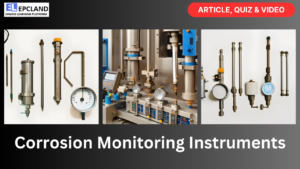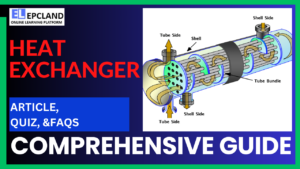1. Design Pressure
What does the design pressure refer to in the valve selection process?
Explanation: The design pressure in the valve selection process refers to the maximum pressure that the valve will be exposed to during normal operation.
2. Valve Body
What is the main structural component of a valve?
Explanation: The valve body is the main structural component of a valve. It provides the main framework for the valve structure.
3. Service Limitations
What do service limitations in valve selection refer to?
Explanation: Service limitations in valve selection refer to restrictions on the valve imposed by the operating conditions, such as fluid temperature, pressure, etc.
4. Finalizing Valve Selection
What factors should be considered when finalizing valve selection?
Explanation: When finalizing valve selection, factors to consider include cost, availability, and ease of maintenance, in addition to other design parameters.
5. Technical Description
What information should be included in the full technical description of a valve?
Explanation: The full technical description of a valve should include information such as valve type, material, flange rating, size, and end connections.
6. Valve Trim
What part of the valve controls the flow of fluid?
Explanation: The valve trim is the part of the valve that controls the flow of fluid through the valve.
7. Valve Actuator
What is the function of a valve actuator in the valve selection process?
Explanation: The valve actuator is the device that opens and closes the valve, providing the necessary control over the valve’s operation.
Short Article on Valve Selection Process
Valve Selection Process
The valve selection process is a critical step in the design and construction of any piping system. The right valve must be selected for the specific application in order to ensure that the system operates safely and reliably. The following is a general procedure for selecting valves and valve components:
1. Identify the necessary design information.
The first step in the valve selection process is to identify the necessary design information. This information includes:
- Design pressure: The maximum pressure that the valve will be exposed to during normal operation.
- Design temperature: The maximum temperature that the valve will be exposed to during normal operation.
- Fluid properties: The properties of the fluid that will be flowing through the valve, such as the type of fluid, the viscosity of the fluid, and the specific gravity of the fluid.
- Valve function: The function of the valve, such as blocking flow, throttling flow, or preventing flow reversal.
- Material: The material of the valve, which must be compatible with the fluid and the operating conditions.
2. Identify potentially appropriate valve types and components.
Based on the design information, the next step is to identify potentially appropriate valve types and components. This includes identifying the type of valve body, the type of valve trim, and the type of valve actuator.
- Valve body: The valve body is the main structural component of the valve. There are many different types of valve bodies, such as ball valve bodies, butterfly valve bodies, gate valve bodies, and globe valve bodies.
- Valve trim: The valve trim is the part of the valve that controls the flow of fluid. There are many different types of valve trims, such as ball valve trims, butterfly valve trims, gate valve trims, and globe valve trims.
- Valve actuator: The valve actuator is the device that opens and closes the valve. There are many different types of valve actuators, such as manual actuators, electric actuators, pneumatic actuators, and hydraulic actuators.
3. Determine valve application requirements.
The next step is to determine the valve application requirements. This includes identifying the design or service limitations of the valve.
- Design limitations: Design limitations are restrictions on the valve that are imposed by the design of the valve itself. For example, a ball valve may have a design limitation that prevents it from being used in applications where the fluid flow is highly erosive.
- Service limitations: Service limitations are restrictions on the valve that are imposed by the operating conditions of the valve. For example, a gate valve may have a service limitation that prevents it from being used in applications where the fluid temperature is above a certain value.
4. Finalize valve selection.
Based on the above steps, the valve selection can be finalized. If two or more valves are suitable, the factors that need to be considered include the cost of the valve, the availability of the valve, and the ease of maintenance of the valve.
5. Provide a full technical description.
The final step in the valve selection process is to provide a full technical description of the valve. This includes specifying the valve type, the material of the valve, the flange rating of the valve, the size of the valve, and the end connections of the valve.
Table of Contents
Don’t miss the Course on Effective Isometrics Management: Check Now
Enrollment Link
Recommended courses (Published on EPCLand)
- Complete Course on Piping Engineering
- Basics of Piping Engineering
- Piping Layout Engineering
- Piping Material Engineering
- Piping Stress Analysis
- Material Requisitions
- Piping Material Specifications
- Valve Material Specifications
- Plant Design & Layouts-OISD 118
- Isometric Management
Library of Technical Articles
Don’t miss out the collection of 15+ articles on following topics:
- Basics of Oil and Gas Industry
- Valves
- Testing
- Tank
- Piping Bulk Items
- Pipe
- Metallurgy
- Piping Materials
- Layout
- Instrumentation
- Heat Exchanger
- Type of Contracts
- Codes and Standards
- ASTM Standards
- Articles on Piping Specialty Items
Video details of Complete Course on Piping Engineering
Why Enroll in the EPCLand
Proven Track Record– PTR
Activities & Achievements before launching EPCLand
- Published more than 50+ short courses
- 3000+ Enrolments
- More than 3,500,00 Minutes of watch hours in the last 2 years
- 4000+ Students in 100+ Countries
- Rating of 4+ out of 5
- 1000+ YouTube Videos
- 8K+ Subscribers
What Students will Learn
- Codes & Standards of the Energy Sector
- Piping Material Engineering
- Piping Layout Engineering
- Stress Analysis
Interesting facts
- All the published courses have been developed by Industry Experts with more than 2 decades of experience
- Content is based on Practical experience and real-time problems.
- Content is designed and organized in such a manner that it can be easily grabbed.
- Complete website, Blogs and Quiz sections are Planned, Designed and published by myself (About me: Atul Singla)
- Complete flexibility of Time & Location, Students can access the content from anywhere & anytime
- Moreover, once enrolled, the content can be access as many times as you want, which helps in understand the fundamentals in a better way.
Conclusion
In conclusion, our courses are meticulously crafted by industry experts with over two decades of hands-on experience. The content is rooted in practical knowledge, addressing real-time problems. The material is thoughtfully designed and organized for easy comprehension. Every aspect, from the website to blogs and quizzes, has been planned, designed, and executed by Atul Singla, ensuring a comprehensive and seamless learning experience. With the flexibility of accessing the content at any time and from any location, students have the freedom to learn on their terms. Furthermore, enrollment grants unlimited access, allowing learners to revisit the material as often as needed, fostering a deep understanding of the fundamentals.



